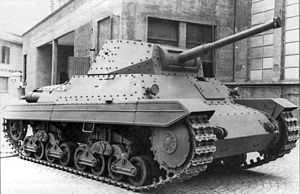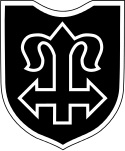24th Waffen Mountain Division of the SS Karstjäger
| 24th Waffen Mountain Division of the SS Karstjäger | |
|---|---|
|
Insignia of the 24th Waffen Mountain Division of the SS Karstjäger[1] | |
| Active | 1944–45 |
| Country |
|
| Branch |
|
| Type | Mountain infantry |
| Role | Anti-partisan operations |
| Size | Division (never reached more than brigade size) |
| Nickname | Karstjäger |
| Engagements |
|
| Insignia | |
| Identification symbol | Týr rune |
The 24th Waffen Mountain Division of the SS Karstjäger was a German mountain infantry division of the Waffen-SS, the armed wing of the German Nazi Party that served alongside but was never formally part of the Wehrmacht during World War II. Named Karstjäger, it was one of the thirty-eight divisions fielded by the Waffen-SS. Formed on 18 July 1944 from the SS Volunteer Karstwehr Battalion, its nominal strength was never more than theoretical and the division was soon reduced to the Waffen Mountain (Karstjäger) Brigade of the SS. Throughout its existence as a battalion, division and brigade, it was primarily involved in fighting partisans in the Karst region on the frontiers of Yugoslavia, Italy, and Austria; the mountainous terrain required specialized mountain troops and equipment.
Founded in 1942 as a company, the unit consisted mainly of Yugoslav Volksdeutsche and recruits from South Tyrol (in modern-day Italy). Although primarily focused on anti-partisan operations, it also saw action in the wake of the Italian surrender when it moved to disarm Italian troops in Tarvisio and protect ethnic German communities in Italy. In addition, at the end of the war it successfully fought to keep passes into Austria open, allowing German units to escape the Balkans and subsequently surrender to British forces. The remnants of the unit became some of the last Germans to lay down their arms when they surrendered to the British 6th Armoured Division on 9 May 1945.
History
Origins

In mid-1942, the Waffen-SS formed a company intended for anti-partisan operations in the rugged and high-altitude border region between Italy, Austria and Yugoslavia known as the Karst.[2] SS-Standartenführer (Colonel) Hans Brandt, a geologist and speleologist, suggested the creation of the unit.[3] The company was formed at the SS training centre at Dachau on 10 July 1942 from soldiers of the supply services training and replacement battalion of the 23rd Waffen Mountain Division of the SS Kama (2nd Croatian).[4]
It was expanded to battalion strength of around 500 troops in November 1942, and as the SS-Freiwilligen-Karstwehr Battalion,[5] it spent the first six months of 1943 training in Austria.[2] The unit drew its recruits mainly from Yugoslav Volksdeutsche (ethnic Germans) and South Tyrolians,[6] with the officer cadre being drawn from SS geological detachments.[3] The battalion-strength Waffen-SS Geological Corps (German: SS-Wehrgeologenkorps) from which such detachments were drawn had been formed in April 1941, and consisted mainly of engineers with a few geologists. They examined caves and natural obstacles, and determined whether off-road terrain was suitable for tanks.[7] They were also responsible for locating sources of fresh water.[8] Following the Italian capitulation in September 1943, the battalion was tasked with disarming Italian troops around Tarvisio on the border between the three countries. It then moved on to protective duties for nearby Volksdeutsche communities. From October 1943 until June 1944, the battalion was based at Gradisca d'Isonzo in Italy, and participated in anti-partisan operations in the areas of Trieste, Udine and the Istrian peninsula.[2] On 10 October, a column of the battalion was ambushed at the Predil Pass, suffering three killed and eight wounded. The following day the battalion burned down the village of Strmc and killed 16 local men in retaliation. Up to 19 October 1943, the battalion suffered a total of 18 killed and 45 wounded in a series of engagements near the village of Flitsch. During the same period, the battalion captured two Italian 75 mm (3.0 in) mountain guns, which significantly increased its firepower.[9]
During late October and November 1943, the battalion was engaged in anti-partisan operations around Saga and Karfreit, including Operation Traufe (Eaves).[9] In late November, the battalion was placed under the command of the Supreme SS and Police Leader, Italy, SS-Obergruppenführer und General der Waffen-SS (Lieutenant General) Karl Wolff for an operation.[10] In February 1944, the battalion conducted Operation Ratte (Rat), during which it burned down the villages of Komen and Rihenberg, and interned the population of both villages in labour camps. Early in 1944, Brand suggested that Slovene nationalists be recruited into the battalion, but the idea was rejected by SS headquarters, who feared that such a policy would allow the infiltration of the unit by Yugoslav Partisans. At this stage, it was estimated that there were about 20,000 communist partisans operating in the Gorizia region. During March 1944, the battalion was involved in a rapid series of named operations, including Zypresse (Cypress), Märzveilchen (Violet), Maulwurf (Mole) and Hellblau (Light Blue), resulting in significant guerilla casualties, as well as executions of captured partisans. In March and April, Operation Osterglocke (Daffodil) was conducted over 12 days, followed by Operation Liane in late May, and the long-running Operation Annemarie which covered the period 7 May to 16 July 1944.[11] In June 1944, a patrol from the battalion failed to return from a task in the vicinity of Cividale del Friuli. Two days later, they were located with their torsos stripped naked and their severed heads impaled on bayonets.[9] The unit became known for shooting suspected partisans.[3] While engaged in anti-partisan work, the battalion grew to a strength of around 1,000.[2]
Expansion

On 18 July 1944,[4] Reichsführer-SS Heinrich Himmler ordered that the battalion be expanded to divisional size, although the authorised strength was only 6,600 troops. The 24th Waffen Mountain Division of the SS Karstjäger was to be established by the Higher SS and Police Leader (German: Höhere SS-und Polizeiführer) for the Operational Zone of the Adriatic Littoral, SS-Gruppenführer (Major General) Odilo Globocnik.[2] The name Karstjäger was derived from a combination of Karst, denoting the region of operations, and Jäger, the German military term for light infantry. The division was to consist of two Gebirgsjäger (mountain infantry) regiments, with an artillery regiment, reconnaissance, Panzerjäger (anti-tank) and pioneer battalions, as well as replacement and supply troops.[12] The division was supplied with 14 captured Italian Carro Armato P 40 tanks, but these proved unreliable, with only half being serviceable at any one time.[13] In August 1944, the under-strength division participated in Operation Dachstein under the command of the 188th Mountain Division.[14] Between August and November 1944, the division continued performing anti-partisan duties in the same region, but its strength had only reached 3,000, less than half of its authorised establishment. It proved impossible to recruit sufficient troops for the division, and in December 1944 the division was downgraded to a brigade.[15]
During late 1944 and early 1945, the Waffen Mountain (Karstjäger) Brigade of the SS fought first against British-supported partisans in the Julian Alps, and was then deployed to the coastal area around Trieste and the Marano-Grado Lagoon. In danger of being cut off by Allied forces, the brigade soon returned to the Julian Alps, having to fight its way through the Tagliamento river valley between Osoppo and Gemona. Toward the end of April 1945, the brigade fought British and New Zealand forces on the southern fringe of the Julian Alps.[16] The brigade replacement company, which had been sent to Cividale from Pottenstein, managed to destroy a number of British tanks with panzerfausts and the assistance of a tank company.[17] In the final weeks of the war the brigade was part of a Kampfgruppe (battlegroup) commanded by SS-Brigadeführer und Generalmajor der Waffen-SS (Brigadier) Heinz Harmel, which was ordered to keep the Karawanken passes open between Yugoslavia and Austria. This task was critical in allowing German forces to withdraw from Yugoslavia in order to surrender to British rather than Yugoslav forces. The Kampfgruppe succeeded in its final task, and was one of the last German units to surrender, when it encountered the British 6th Armoured Division on 9 May 1945.[2]
Order of battle
On paper, the division's final order of battle was to consist of:[12]
- 59th Waffen Gebirgsjäger (Mountain Infantry) Regiment of the SS (three battalions)
- 60th Waffen Gebirgsjäger Regiment of the SS (three battalions)
- 24th SS Mountain Artillery Regiment (four battalions)
- 24th SS Reconnaissance Battalion
- 24th SS Panzerjäger (Anti-tank) Battalion
- 24th SS Pioneer Battalion
- 24th SS Mountain Signals Battalion
- 24th SS Replacement Battalion
The division establishment also included supply units. However, only the 59th Waffen Gebirgsjäger Regiment, one battalion of the 24th SS Mountain Artillery Regiment, one company of the 24th SS Pioneer Battalion and a half-company of the divisional panzer company were ever established.[15]
Commanders
According to Gordon Williamson, three Waffen-SS officers commanded the division and subsequently the brigade:[2]
- SS-Obersturmbannführer Karl Marx (Dec 1944)
- SS-Sturmbannführer Werner Hahn (Dec 1944 – Feb 1945)
- SS-Oberführer Adolf Wagner (Feb – May 1945)
In contrast, Roland Kaltenegger only lists Hahn as commanding the unit.[15]
Uniform
The unit insignia was a stylised Týr rune with arrows pointing to the left and right.[15] A collar insignia was manufactured, but it is believed that these were never issued or worn, and the members of the division wore the Sig runes.[18]
See also
- List of Waffen-SS units
- Table of ranks and insignia of the Waffen-SS
- Waffen-SS foreign volunteers and conscripts
Notes
- ↑ Keegan 1970, p. 139.
- ↑ 2.0 2.1 2.2 2.3 2.4 2.5 2.6 Williamson 2004, p. 4.
- ↑ 3.0 3.1 3.2 Blood 2006, p. 263.
- ↑ 4.0 4.1 Kaltenegger 2008, p. 81.
- ↑ Kaltenegger 2008, p. 84.
- ↑ Bishop & Williams 2003, p. 72.
- ↑ Häusler & Willig 2000, p. 154.
- ↑ Blood 2006, p. 57.
- ↑ 9.0 9.1 9.2 Kaltenegger 2008, p. 348.
- ↑ Kaltenegger 2008, pp. 348–349.
- ↑ Kaltenegger 2008, p. 349.
- ↑ 12.0 12.1 Kaltenegger 2008, pp. 85–86.
- ↑ Cappellano & Battistelli 2012.
- ↑ Kaltenegger 2008, pp. 349–350.
- ↑ 15.0 15.1 15.2 15.3 Kaltenegger 2008, p. 86.
- ↑ Kaltenegger 2008, pp. 353–354.
- ↑ Kaltenegger 2008, p. 354.
- ↑ Williamson 2004, p. 5.
References
- Bishop, Chris; Williams, Michael (2003). SS: Hell on the Western Front. Saint Paul, Minnesota: MBI Publishing. ISBN 978-0-7603-1402-9.
- Blood, Philip W. (2006). Hitler's Bandit Hunters. Washington, D.C.: Potomac Books. ISBN 978-1-59797-445-5.
- Cappellano, Filippo; Battistelli, Pier Paolo (2012). "Medium Tanks in German Service". Italian Medium Tanks: 1939–45. Oxford, Oxfordshire: Osprey. ISBN 978-1-84908-775-9.
- Häusler, Hermann; Willig, Dierk (2000). "Development of Military Geology in the German Wehrmacht 1939–45". In Rose, Edward P.F.; Nathanail, C. Paul. Geology and Warfare: Examples of the Influence of Terrain and Geologists on Military Operations. Bath, Somerset: Geological Society. pp. 141–158. ISBN 978-1-86239-065-2.
- Kaltenegger, Roland (2008). Totenkopf und Edelweiss: General Artur Phleps und die südosteuropäischen Gebirgsverbände der Waffen-SS im Partisanenkampf auf dem Balkan 1942–1945 [Skull and Edelweiss: General Artur Phleps and the Southeastern European Mountain Units of the Waffen-SS in the Partisan Struggle in the Balkans 1942–1945] (in German). Graz, Austria: Ares Verlag. ISBN 978-3-902475-57-2.
- Keegan, John (1970). Waffen SS: The Asphalt Soldiers. London, United Kingdom: Pan/Ballantine. ISBN 978-0-345-09768-2.
- Williamson, Gordon (2004). The Waffen SS (4): 24. to 38. Divisions, & Volunteer Legions. Oxford, Oxfordshire: Osprey. ISBN 978-1-84176-592-1.
| ||||||||||||||||||||||||||||||||||||||

.svg.png)